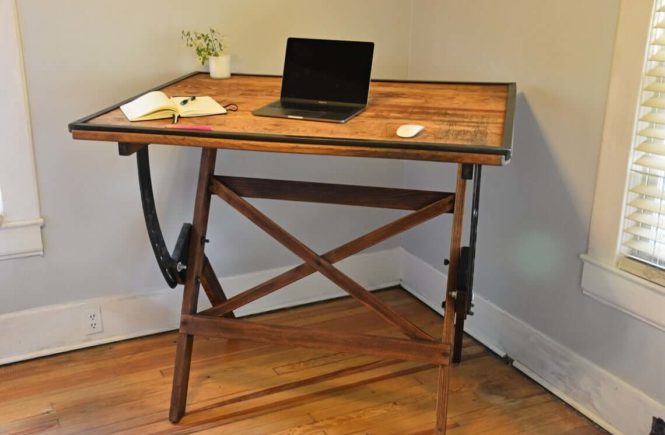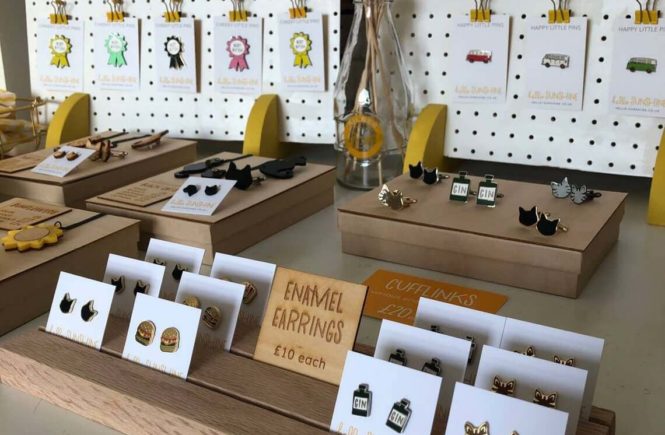[vc_row][vc_column][vc_message bb_tab_container=””]Niche : Home and Living
Shop link : https://www.etsy.com/shop/Design2Resource
Instagram : https://www.instagram.com/design2resource[/vc_message][/vc_column][/vc_row][vc_row][vc_column][vc_column_text]
Tell us something about yourself, how did you get started, do you consider yourself a crafter,maker,artist…
I consider myself a “maker” more than a crafter or an artist. “Crafter” and “artist” seem too pretentious.
I started furniture only two years ago but remodeled for fifteen. I’m a licensed General Contractor in a few states.
Stressed from a remodel, I started sanding a random board in the backyard. First a shelf, then a top. I brought stuff to the weekend market and it was a hit!
How did you discover Etsy? Did you have any previous experience in selling handmade products? Why did you start selling online?
Initially, Etsy sales were just in the background, but luckily as Covid started to really put a damper on outdoor markets, the Etsy sales became consistent.
Our folding desk is well-timed for home offices wanting something a bit more versatile, inspiring (and long-lived) than a boring, mass-produced desk.
What products do you sell, what type of materials are used in your creations, how do you design your products, what makes your products stand out ?
I’ve always loved using reclaimed waste. “Design2Resource” literally means designing things TO the given resource, which is salvaged, found, thrifted, surplus, or otherwise readily available. Never “junky”, mishmash or slapped together. Conscious design, yes, but also design-conscious.
We’re building the first architecture-neutral shipping container house! It will be indistinguishable from a regular house and less expensive to build! It takes the side panels out and uses them as a metal roof!
This project yielded spare container doors and heavy-duty industrial hardware, so I “D2R’ed” the furniture around those parts! The “Industrial Bar Cart” in our Etsy shop is our first serious piece of “purposeful repurposing”. The container hardware is meant to look authentically industrial, but it’s also reused in a way that’s true to its original function.
I stumbled upon a pile of roof slats in excellent condition, and they became the basis for my floating desk!
[/vc_column_text][/vc_column][/vc_row][vc_row][vc_column width=”1/3″][vc_single_image image=”100001172″ img_size=”737×737″ onclick=”link_image” css_animation=”appear” bb_tab_container=””][/vc_column][vc_column width=”1/3″][vc_single_image image=”100001171″ img_size=”737×737″ onclick=”link_image” css_animation=”appear” bb_tab_container=””][/vc_column][vc_column width=”1/3″][vc_single_image image=”100001170″ img_size=”737×737″ onclick=”link_image” css_animation=”appear” bb_tab_container=””][/vc_column][/vc_row][vc_row][vc_column][vc_column_text]
How was your experience in learning to craft, are you self-taught or did you have a mentor, how long did it take for you to be satisfied with your creations
I learned to weld from a good friend, my dad taught me woodwork. But I’ve learned the most about furniture from my carpenter…who was an industrial designer in Venezuela. Not only do we design really well together, but he has the experience to shoot down ideas that won’t work. Of course, I’m often stubborn enough to prove him wrong, or to waste lots of time trying 🙂
I feel very fortunate that the structural side comes naturally to me.
For instance, many designers are afraid to install directly to drywall.
Too many companies leave you “on your own” there because of fear of liability.
Our mantel can hold a person without screwing into studs!
Our hero product, the folding desk, includes all NO-STUD hardware, and you can call us any time during the install. A 100% hassle-free guarantee!
What was your original goal when you opened up an Etsy shop? What impacted your decision to start selling online? Do you consider online selling as a side-job, full-time job or extra income to pay for your hobby?
The idea of Etsy appealed since it casts a wider net than a local market. The same way Amazon has put lots of brick-and-mortar retail out of business, it felt essential to stay relevant.
Did you have any fears or reservations before opening up your Etsy shop? Were you worried about profitability or product competitiveness? What are some concerns and questions you had before you got started? How did you overcome them?
I’m proud to have conquered free shipping. In the Amazon-era, Etsy has strongly encouraged sellers to offer free shipping. Of course, shipping furniture is far from free!
But Etsy has partnered with FedEx, a nice perk, and as sales grow, those fees keep dropping!
For the first time dining chairs, bookcases, and benches at my price-point is feasible without disassembling or flat-packing!
One shipping fear was, “What if they don’t like it?” Or “What if something’s wrong?” But customers are usually very happy, and that’s immensely fulfilling.
How long did it take for you to get your first sale? Did you ever thought you would make a lot of sales in the first year? What was a goal you were hoping for? How many sales an average you get per week?
The road to consistent sales was long, and it’s nice to have reached the steeper part of the curve 🙂 I’m very superstitious about both past and future successes.
If you’re hustling and evolving, you’ll probably succeed.
Do you have a job outside Etsy? If not, are you able to commit full-time to online selling? How does your typical day look like? How do you manage time?
We’re remodeling our house to sell, but luckily we can do that around other commitments. I won’t turn down a deck job or a bathroom job, but right now Etsy is the main focus. I recommend a wonderful book called “Work Simply”, which pinpoints your productivity style.
There are four different types and I promise you’ll be shocked how much one or two of them resonate with you!
The book taught me that I’m a “Visualizer” and that my work schedule and work environment should be pretty informal. It taught me to break-up repetitive tasks so I’ll stay engaged.
Doing those things without feeling guilty has been very liberating!
So if I can make 15 sets of hardware or 20 wood tops or 10 steel bandings, I’d say it was a good day.
My goal is to have every model on hand, ready to ship, and I’m very close to that goal!
How does your manufacturing process looks like for e.g. your best selling product? Do you create products ahead of the orders? Do you customize your products, if so how? What are tools that you are using in manufacturing process?
Our folding desk is priced very competitively. For reclaimed wood, welded frame, powder-coated hardware product with free shipping, we’ve had to do A LOT of innovation and jig-making.
We have a jig to weld the hardware arms, a jig for the offset, a jig for the flanges, a jig to insert the rivets, a jig to insert the nut inserts, a special tool to clamp the tops down, and secret jigs we can’t tell you about 🙂
We’re happy to customize so long as our “bandwidth” allows!
What is the biggest impact on profitability of your shop? How expensive are the materials you use? How do you price your products?
Often with “profitability” you have to “run and pray you catch the bus”. My main worker (the industrial designer from question 4) is a bit of a perfectionist. I’ve had to micromanage a few steps to boost profit. He would spend an hour per piece sanding a tiny detail, with minimal benefit. If every dollar spent equals 2x wholesale and 4x retail, then $20-25 labor = $80-100 ticket price!
Profitability is the life-blood. At first, he was hesitant, but he came around.
I also credit him with another profitability boost to the shop. Initially, the desk was available in every possible even-number inch increment, for a total of 120 different combinations!
It’s impossible to develop muscle memory working with that many different SKU’s and impossible to batch-produce, and the chance for error is much greater.
He said “Far fewer choices. People will adapt”.
With 5 sizes total, I know exactly which clamps and jigs to go to, I can eyeball the sizes right off the shelf, I can memorize what the package will weigh, etc.
What inspires you when you’re creating? How do you get ideas for new products? What are some methods or tools you use to get creative?
I like to tinker. There are bits of hardware scattered throughout my world, on my nightstand, in my pockets. I love going to the scrapyard and thrift store. You find old relics that were made differently back then. You see the guts of things you wouldn’t otherwise.
Mass-production design is a remarkably small span of the overall spectrum. But that’s the creative freedom of being a smaller fish.
Do you ship your product internationally? How do you handle postage pricing? What is average time it takes from the order to the delivery? Do you use free shipping? If so, why? How do you package your products?
I don’t ship internationally but I would definitely like to. Once I’m fully satisfied with the shop’s catalog I will definitely tackle that frontier. I’m moving towards much shorter turnaround times. I’m at about 8 days now, but will definitely get it down to 3-5 business days soon.
I believe you HAVE to offer free shipping these days. I had a customer from Canada inquire about a $500 bench and ask about shipping. For some reason, Fedex’s website was down, so I told her we could split the shipping $75 each. $150 was a best-case guess of what shipping would be, with the higher end being $250-$300. She balked, and in retrospect, I should have just offered free shipping for the business and the experience.
I think I’ve packed 30 floating desks in 30 different ways. I’ve used bubble-wrap, shrink-wrap, single-walled cardboard, styrofoam. Flooring underlayment is a good option.
I bought a crating stapler and built some crates…argued with the shipping center that it was a crate and not a “pallet”, even though, yes, to save on weight, there were gaps between the slats.
They gave me looks and acted like they were going to get “splinters”.
Packing strategy is very product-specific, but you have to know the exact shipping properties of what you’re shipping: IE: does your product need to be protected from shock, or does it really just need to be protected from surface damage?
I’m proud to say I recently broke a record for my lightest and cheapest desk ship (14 lbs and $11) and the customer noted how “securely packed it was”. That’s the level of efficiency I strive for. (see #18).
[/vc_column_text][/vc_column][/vc_row][vc_row][vc_column width=”1/3″][vc_single_image image=”100001169″ img_size=”737×737″ onclick=”link_image” css_animation=”appear” bb_tab_container=””][/vc_column][vc_column width=”1/3″][vc_single_image image=”100001167″ img_size=”737×737″ onclick=”link_image” css_animation=”appear” bb_tab_container=””][/vc_column][vc_column width=”1/3″][vc_single_image image=”100001166″ img_size=”737×737″ onclick=”link_image” css_animation=”appear” bb_tab_container=””][/vc_column][/vc_row][vc_row][vc_column][vc_column_text]
Are you worried about competitors? Does it impact your business in any way? If there are a lot of similar products, how do you make your own stand out?
There’s no original thought but you are an original and unique snowflake. As far as standing out, I just started using Marmalead, so can’t vouch for it yet but it seems very promising.
How do you deal with disputes or bad rating/feedback? How do you manage presale and post sale communication and customer satisfaction?
14. Customer service is non-negotiable. You won’t make money on every sale but your brand prevails in the long run. I like to send clients a picture of their top before it ships. In case it’s not what they expected they can veto it. If it took a bit too long, I’ll throw in a shelf or cutting board.
Has selling on Etsy changed your life in any way? If so, how? Did you ever thought you would get this far with your shop? Have you ever been stressed dealing with customers and manufacturing products? How did you deal with that?
It’s nice knowing I don’t have to drive around to bid on uncertain jobs or schlep tables to uncertain markets.
I can make a living from my garage, and realistically, I could move that garage anywhere in the world. There’s always stress, it’s all worth it in the big picture.
How important is social media for your shop? What are some common tactics you use to promote your products? Do you spend money on ads outside of Etsy? How do you generate excitement/hype around your products?
We post our work on Instagram! Sometimes we promote posts for added visibility. These have definitely led to Etsy business and Etsy has led to more followers.
What are some things you don’t like about Etsy? If you could talk to the CEO of Etsy what recommendations would you tell him to improve sellers and customers satisfaction?
Etsy has grown on me a lot. Even at the prospect of launching my own website vs. Etsy’s platform…their fees are modest in exchange for the visibility and shipping incentives. They do side with the customers during disputes, and you have to jump through hoops to get a human on the other end, but it’s not the end of the world.
What are some things you did to set your shop for success on Etsy? What is one lesson you learned the hard way?
Some sellers say “this is beautiful reclaimed wood, and it’s $600 and another $300 to ship it across the country”, and I tip my hat to them because they have the discipline to do what I wish I could. I know that if I say it’s $400 and I can ship it across the country for free, I’ll sell more of them, I’ll grow faster. Even if the margins are tighter at first and it’s harder to pay people to do the work, it forces me to be tighter all along the production line. (See #12)
What piece of advice would you give to new or established sellers or those considering to sell on Etsy? How can they avoid beginners mistakes?
Once something starts to sell, definitely buy your supplies in bulk from Amazon or Alibaba. At first it may seem like you aren’t making money, but over time your lower production cost will pay off.
Anything you wish to add, feel free to do so here. We value your opinion
Entrepreneur is the French word for “One who takes on”.
Entrepreneurs take on. Unlike a 9-5, you’ve “taken on”, 24/7. But, unlike a 9-5, your income isn’t capped.
“Spend a few years living like most people don’t want to – spend the rest of your life living like most people can’t. -” – Robert Kiyosaki (Rich Dad Poor Dad).
[/vc_column_text][/vc_column][/vc_row]




